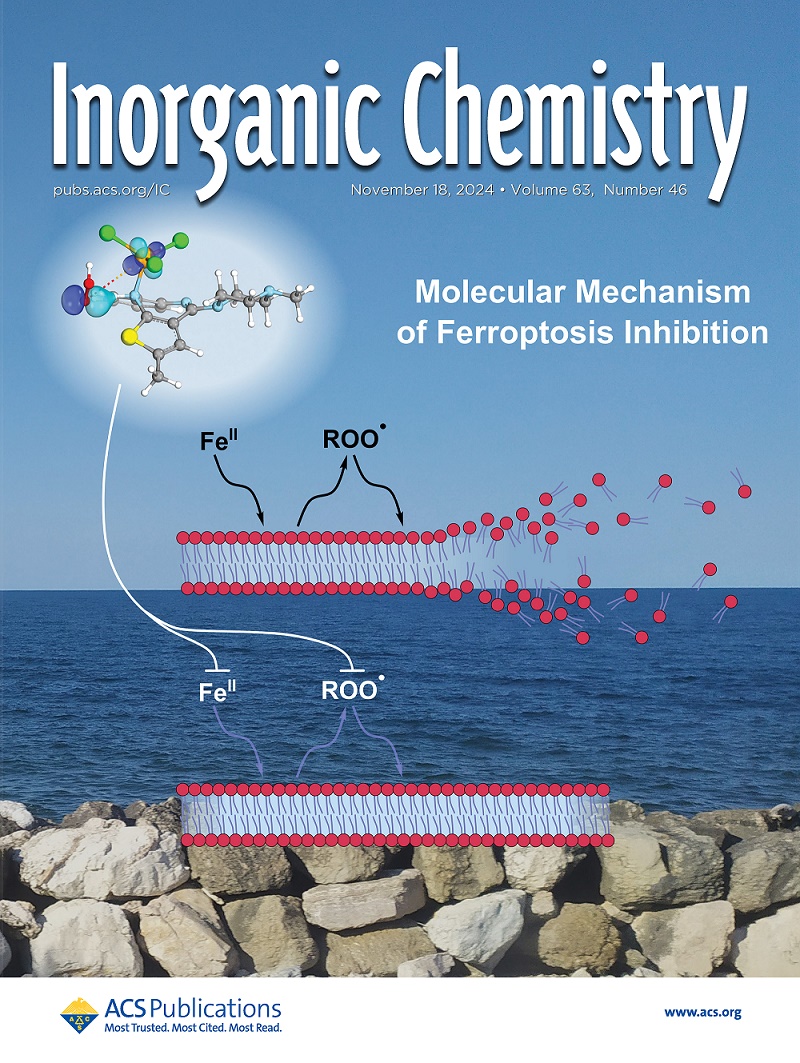Alternative Metal with an Alternative Mechanism for Metalloporphyrin-Enabled NO Reduction to N2O: A Combined Computational and Experimental Investigation of NO Reduction by Cr Porphyrin with Lewis Acid
IF 4.3
2区 化学
Q1 CHEMISTRY, INORGANIC & NUCLEAR
引用次数: 0
Abstract
Nitric oxide (NO) is an important molecule that regulates many physiological processes in humans and plants and contributes to the formation of greenhouse gases. Bacterial NO reductases utilize a di-Fe heme/nonheme active site to couple two NOs to generate nitrous oxide (N2O) via a two-electron mechanism. Here, we report a previously unexplored Cr porphyrin NO complex with a Lewis acid (LA) BF3 for the NO reduction reaction. Density functional theory calculations were first employed to reveal its reaction mechanism with a reasonable barrier for experimental realization. Subsequent experimental synthesis work confirms this reactivity and reports the first nitrosyl Cr porphyrin X-ray crystal structure. Theoretical analysis uncovered a distinctive reaction feature for the Cr system compared to Fe and Co porphyrins: the electron transfer from the metal to the bound NO occurs before LA binding. A comparative study of the NO coupling mechanisms with the three representative metals suggests that the metal reduction potential should be finely tuned, as found in previous studies of NOR enzymatic systems. Overall, this study offers new theoretical and experimental insights to further facilitate the development of alternative NO reduction compounds with biological, environmental, and industrial applications.

金属卟啉使NO还原为N2O的替代机制:Cr卟啉与Lewis酸还原NO的计算与实验研究
一氧化氮(NO)是调节人类和植物许多生理过程的重要分子,也是温室气体形成的原因之一。细菌一氧化氮还原酶利用二铁血红素/非血红素活性位点,通过双电子机制将两个一氧化氮耦合生成一氧化二氮(N2O)。在此,我们报告了一种以前未曾探索过的 Cr卟啉 NO 复合物与路易斯酸(LA)BF3 的 NO 还原反应。我们首先利用密度泛函理论计算揭示了其反应机理,并为实验实现设置了合理的障碍。随后的实验合成工作证实了这种反应性,并首次报告了亚硝基铬卟啉的 X 射线晶体结构。理论分析发现,与铁卟啉和钴卟啉相比,铬卟啉体系有一个独特的反应特征:从金属到结合 NO 的电子转移发生在 LA 结合之前。对 NO 与三种代表性金属耦合机制的比较研究表明,正如之前对 NOR 酶系统的研究中发现的那样,金属还原电位应进行微调。总之,这项研究提供了新的理论和实验见解,进一步促进了具有生物、环境和工业应用价值的替代性 NO 还原化合物的开发。
本文章由计算机程序翻译,如有差异,请以英文原文为准。
求助全文
约1分钟内获得全文
求助全文
来源期刊

Inorganic Chemistry
化学-无机化学与核化学
CiteScore
7.60
自引率
13.00%
发文量
1960
审稿时长
1.9 months
期刊介绍:
Inorganic Chemistry publishes fundamental studies in all phases of inorganic chemistry. Coverage includes experimental and theoretical reports on quantitative studies of structure and thermodynamics, kinetics, mechanisms of inorganic reactions, bioinorganic chemistry, and relevant aspects of organometallic chemistry, solid-state phenomena, and chemical bonding theory. Emphasis is placed on the synthesis, structure, thermodynamics, reactivity, spectroscopy, and bonding properties of significant new and known compounds.
 求助内容:
求助内容: 应助结果提醒方式:
应助结果提醒方式:


